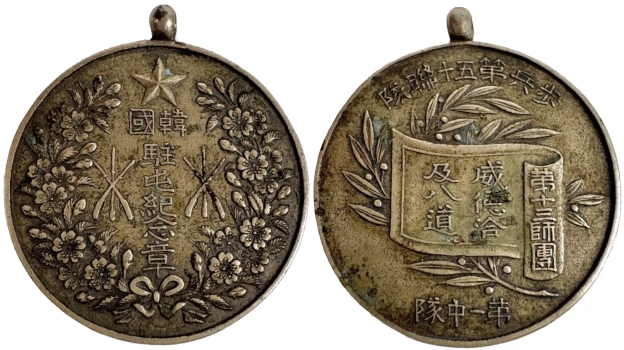
Garrison Duty
Obverse: 韓國 (한국 Han Kuk) Korea, 駐屯記念章 (주둔기념장) Garrison Service Commemorative. The Japanese did not use the term Chosŏn 朝鮮 to describe Korea until after it was legalized on August 29, 1910 (Meiji 43), when Japan promulgated and enacted Imperial Decree No. 318, entitled “Rename Korea to Chosŏn” (韓国ノ国号ヲ改メ朝鮮ト称スルノ件).
Reverse: 歩兵第五十聯隊 (보병제오십련대) 50th Infantry Regiment, 第一中隊 (제일중대) 1st Company, 第十三師團 (제십삼사단) 13th Division, and 威徳洽及八道 (위덕흡급팔도) Virtue and Benevolence to the Eight Provinces. There is another possible translation for this last inscription, namely: 威徳洽及ハ道 (위덕흡급ハ도) Way of Virtue and Authority. (The Japanese Katakana phonetic symbol “ハ” does not translate into Korean.)
In 1906, the 13th Division was dispatched for garrison duty in Korea. I have been unable to establish where they were garrisoned in Korea. They left Korea in 1908. For more information on the Japanese 13th Division, and to see another variation of this medal, go to the Medals of Asia, 13th Division, webpage.
From April 2, 1906, until April 29, 1908, their regimental commander was Colonel Nobuaki Yamamoto 山本延身 (산本延身 1863 – 1917). He eventually became a Major General and the recipient of the Japanese Order of the Rising Sun, both 4th and 5th Class. From the Korean Empire he received the Order of the Eight Trigrams, 2nd Class on Nov. 19, 1908.1 The Japanese government authorized the wearing of the Korean Order on March 11, 1911.2 On Aug. 1, 1912, he received the Korean Annexation Medal.
At the end of World War II, the primary Imperial Japanese Army force defending the island of Tinian was the 50th Infantry Regiment, commanded by Colonel Kiyochi Ogata 绪方敬志. The regiment had been stationed near Mukden, Manchuria, from 1941 until 1944. After which it was transferred to Tinian Island, arriving in March of 1944. At the time, it was composed of well-trained combat veterans. Fortunately for the Americans, Japanese army tactics of the time favored mass frontal assaults, which resulted in large numbers of lives being squandered needlessly. More than 2,000 Koreans survived the Battle of Tinian and were repatriated back to Korea in late 1945 – 1946.
Footnotes:
- Yi Kang-chil 이강칠 (李康七) KOREAN EMPIRE ERA, DECORATION SYSTEM 대한제국시대 훈장제도, (1999), publisher 백산출판사, p. 166.
- Recorded in the Japanese Official Gazette No. 8313.
